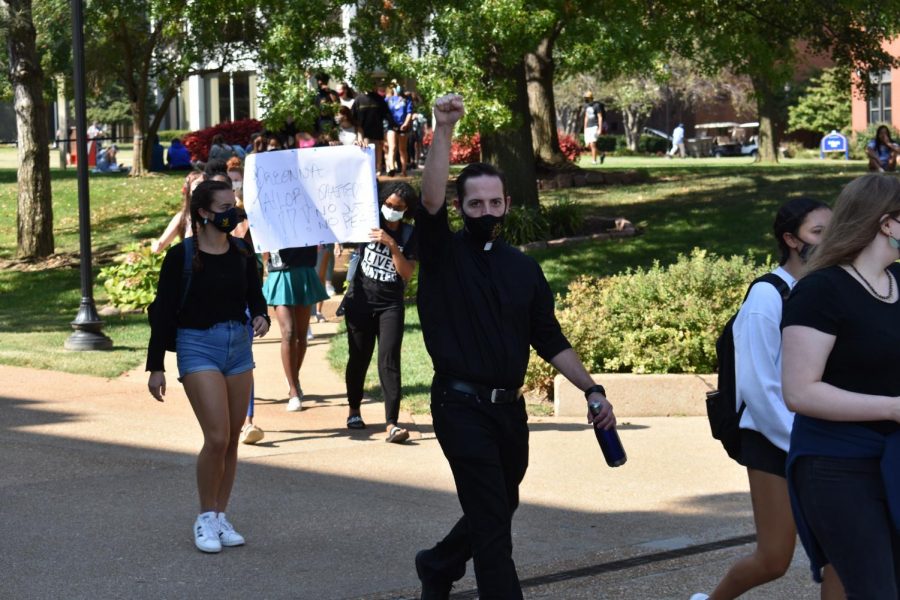On March 28, Sr. Helen Prejean, C.S.J., will speak at Saint Louis University. Nominated several times for the Nobel Peace Prize, she is widely known for her 1994 bestselling book, “Dead Man Walking: An Eyewitness Account of the Death Penalty in the United States.” Tim Robbins’ film “Dead Man Walking” was based on it and released in 1996, starring Susan Sarandon, who played the part of Sr. Helen and won an Oscar for Best Actress, and Sean Penn, who played the part of Matt Poncelet, a death row inmate (actually a composite character based on two death row inmates in the book,) and was nominated for Best Actor.
I saw the movie when it first appeared while I was in graduate school. Since then I have used both the book and the movie in a number of my theology and ethics courses. Each is as timely as ever.
Prejean raises the standard concerns about capital punishment (e.g., racial bias, wrongful convictions of the innocent, lack of effectiveness as a deterrent, etc.), but it is her first-hand experience of wrestling with the question of how to embody God’s love for both the perpetrator and the victim (and each of their families) that powerfully engages her audience—including me, because to some extent I can relate to it.
As a young undergraduate who needed to work my way through a state university in Florida, I joined the ranks of a 1,500-member sheriff’s department. For four years I attended classes during the day while working full time during the midnight shift. Often assigned to the central booking area in the maximum security jail, I witnessed some of the worst in human behavior.
I remember one night when I had to interview an elderly man who had allegedly stabbed his own daughter-in-law—along with her own daughter—to death. He sat stoically while I questioned him. I wondered how he could have done such an abhorrent act, and deep inside I felt tempted to shake him in disgust.
Other offenders were not so indifferent. There were occasions when I had to dive for cover from hurled excrement, or when I had to defend myself (or others) against attack. I’ve been spit at, yelled at, verbally abused, bruised and cut. When talking to some inmates, I thought to myself that some probably would not hesitate to kill me if given the chance. But I also met several murderers who were in anguish and seemed penitent about their deeds.
Although at times it was exciting, I never truly enjoyed that job. I preferred the classroom and longed for the day when I would be able to quit wearing a badge and begin graduate studies. As a Christian, I struggled over the use of force, the perpetual hostility and the intense emotions of anger and hatred that often flared. Still, the crimes that these persons committed—as well as the family and friends of the victims—cried out for justice.
That stint in law enforcement (and another one later) now seems like a lifetime ago. Sr. Helen’s story, though, helps me to remember. In the movie version of “Dead Man Walking,” Poncelet, is a racist and misogynist murderer who still somehow shows a human side on death row. The sheer horror of his crime, which the film depicts more than once, evokes feelings of disgust and anger.
Those who restrict their consideration solely to this will probably have no qualms about his state-sanctioned execution. Indeed, in the book, Prejean makes clear her initial hesitation to become involved with such an offender.
But as Poncelet’s spiritual advisor during his final months before his execution, Prejean comes to view him as a human person, despite his constant complaining and self-pitying. At times I saw this human side of the person behind bars. So did my mother, Patricia Juhl, who was a homicide detective. Over a period of six years, she met with Anthony Joseph LeRette on death row here in Missouri, while he described for her his multiple murders, rapes and robberies in several states, including Florida, and told her where the bodies of his victims could be found. In a letter to my mother, the barely literate LeRette wrote, “I seen in your eyes and speech that I could trust you somewhat. You’re still the law and I know that you will do your job. But there’s a heart in Pat that does care.” His crimes were horrific, but my mother slowly developed a rapport with him, even to the point where she said, “I got to know him as Tony LeRette on death row. I got to know him as a human being” (St. Petersburg Times, Dec. 3, 1995, pp. 1B, 5B). LeRette was executed in Missouri by lethal injection in November 1995.
In “Dead Man Walking,” director Robbins vividly depicts this human dimension of Poncelet, especially during the final moments leading up to his execution.
Those who restrict their consideration solely to this will probably have serious qualms about his state-sanctioned execution. Yet, Robbins, according to Sister Helen, did not want the film labeled as anti-death penalty, even though her book indeed takes such a stance, which is why the horror of what Poncelet did is repeatedly shown in the movie—to generate as much sympathy for the victims (and their families) and aversion for the crime as cinematically possible.
Importantly, in both the movie and the book, Prejean visits with the murder victims’ families. She is confused and torn, feeling their pain. They often seek “eye for an eye” justice to help them to cope with their tragic loss, and Prejean tries her best to empathize with them, while still serving as the murderer’s spiritual advisor. For this reason she has helped found “Survive,” a victims’ advocacy group in New Orleans. Her experience of being pulled in two directions also brings to my mind a similar experience I had while serving as a youth pastor at a church in North Carolina.
I tried to comfort a family who had lost two sons in unrelated murders. The father, who was the church’s head usher, appeared on ABC’s “Nightline” advocating the death penalty. In addition, another boy in the youth group, a senior nearing graduation, was shot to death at a party one night, a murder that left a lasting imprint on his family.
At the same time, however, I found myself visiting another young church member who was in jail awaiting trial for allegedly murdering his stepmother. How does one convey the love of God to both the victims and the offenders? Prejean refuses to take sides with only the offender or only the victims; she’s on both of their sides.
Highlighting this tightrope walk is one of the strengths of the book and, especially, the movie. Sarandon’s portrayal of Sr. Helen is so moving that it facilitates a process of Verstehen, whereby the audience identifies empathetically with all those persons involved—Prejean, the victims, the victims’ families, Poncelet, Poncelet’s family—in order that we might interpret capital punishment from each of their perspectives. We come away with what one reviewer, Marc Bruno, described as “a palpable sense of having been asked by both murderer and murdered to give them pity and prayers” (“America,” Feb. 17, 1996, p. 33).
Yet, Sister Helen is not neutral on the subject of capital punishment—she’s against it. She completely rejects it as incongruent with Jesus’ emphasis on and example of love for one’s enemies as well as one’s neighbors. Christians must seriously consider both the victims and the offender as human beings created in the image of God. As Pope John Paul II wrote in “Evangelium Vitae,” “[W]hoever attacks human life, in some way attacks God himself.” Murder is the intentional killing of an innocent human being, whose life is sacred. Murder is the desecration of a creature of God. At the same time, though, the Pope added, “Not even a murderer loses his personal dignity,” which is one of the reasons why the Roman Catholic Church now calls for the abolition of capital punishment “except in cases of absolute necessity: in other words, when it would not be possible otherwise to defend society,” circumstances which John Paul II wrote are “very rare, if not practically non-existent.”
Missouri, like 33 other states in the U.S. today, has the death penalty. In addition to learning more about this issue in classes and through the resources available in the library, I encourage those seeking to inform themselves to attend Sr. Helen’s lecture.
Dr. Winright is a Theology professor at SLU.







